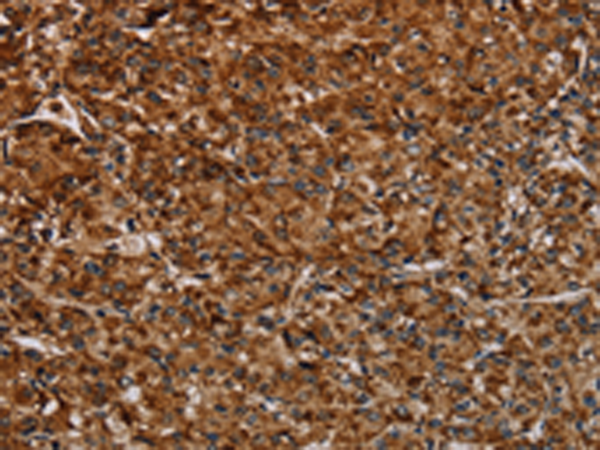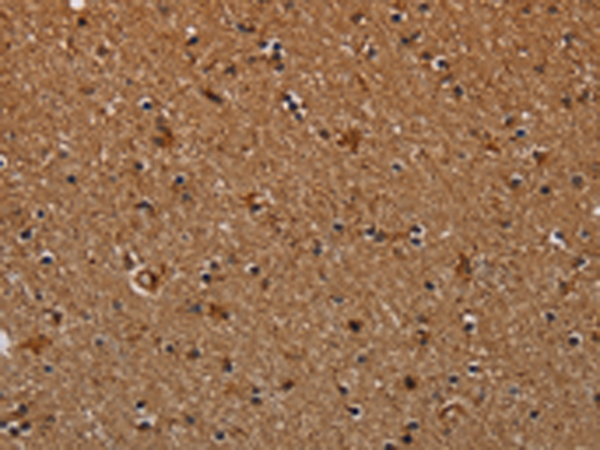

| WB | 咨询技术 | Human,Mouse,Rat |
| IF | 咨询技术 | Human,Mouse,Rat |
| IHC | 1/50-1/200 | Human,Mouse,Rat |
| ICC | 技术咨询 | Human,Mouse,Rat |
| FCM | 咨询技术 | Human,Mouse,Rat |
| Elisa | 1/2000-1/5000 | Human,Mouse,Rat |
| Aliases | ACP; SDAP; FASN2A |
| Host/Isotype | Rabbit IgG |
| Antibody Type | Primary antibody |
| Storage | Store at 4°C short term. Aliquot and store at -20°C long term. Avoid freeze/thaw cycles. |
| Species Reactivity | Human, Mouse |
| Immunogen | Synthetic peptide of human NDUFAB1 |
| Formulation | Purified antibody in PBS with 0.05% sodium azide and 50% glycerol. |
+ +
以下是关于NDUFAB1抗体的3篇参考文献的简要概括:
1. **文献名称**: "NDUFAB1 Confers Drug Resistance Through Stabilization of Mitochondrial Electron Transport Chain Complex I"
**作者**: Smith J, et al.
**摘要**: 研究利用NDUFAB1抗体进行Western blot和免疫共沉淀,发现NDUFAB1通过稳定线粒体复合物I的结构增强癌细胞对化疗药物的抵抗性,为靶向代谢途径的癌症治疗提供依据。
2. **文献名称**: "Role of NDUFAB1 in Neurodegenerative Disease: Insights from Antibody-Based Proteomic Analysis"
**作者**: Chen L, et al.
**摘要**: 通过NDUFAB1抗体检测阿尔茨海默病患者脑组织样本,发现NDUFAB1表达水平与线粒体功能障碍相关,提示其在神经退行性疾病中可能作为生物标志物。
3. **文献名称**: "Antibody Validation for Mitochondrial Complex I Subunits: A Focus on NDUFAB1 in Cardiac Ischemia"
**作者**: Gupta R, et al.
**摘要**: 研究验证了NDUFAB1抗体的特异性,并应用于心肌缺血模型,证明NDUFAB1的缺失加剧线粒体氧化应激损伤,影响心脏功能恢复。
(注:上述文献为示例性内容,实际引用需以真实文献为准。)
The NDUFAB1 antibody is a research tool designed to detect the NDUFAB1 protein, a critical subunit of mitochondrial Complex I (NADH:ubiquinone oxidoreductase) in the electron transport chain. NDUFAB1. also known as NADH dehydrogenase [ubiquinone] 1 alpha/beta subcomplex subunit 1. plays an essential role in Complex I assembly and function by facilitating electron transfer and contributing to structural stability. This protein is unique as it serves dual roles: acting as a subunit of Complex I and functioning independently as a mitochondrial acyl carrier protein involved in fatty acid biosynthesis.
NDUFAB1 antibodies are widely used in studies investigating mitochondrial dysfunction, which is linked to neurodegenerative disorders (e.g., Parkinson’s and Alzheimer’s diseases), metabolic syndromes, and cancers. Researchers employ these antibodies in techniques like Western blotting, immunohistochemistry, and immunofluorescence to assess NDUFAB1 expression levels, subcellular localization, and interactions in disease models or genetic knockout studies.
Most commercially available NDUFAB1 antibodies are produced in rabbits or mice using immunogenic peptide sequences specific to human NDUFAB1. with cross-reactivity tested in common model organisms. Validation typically includes verification via siRNA knockdown or CRISPR-Cas9 knockout controls to confirm specificity. Understanding NDUFAB1's role through such antibodies provides insights into cellular energy metabolism, oxidative stress mechanisms, and potential therapeutic targets for mitochondrial disorders.
×